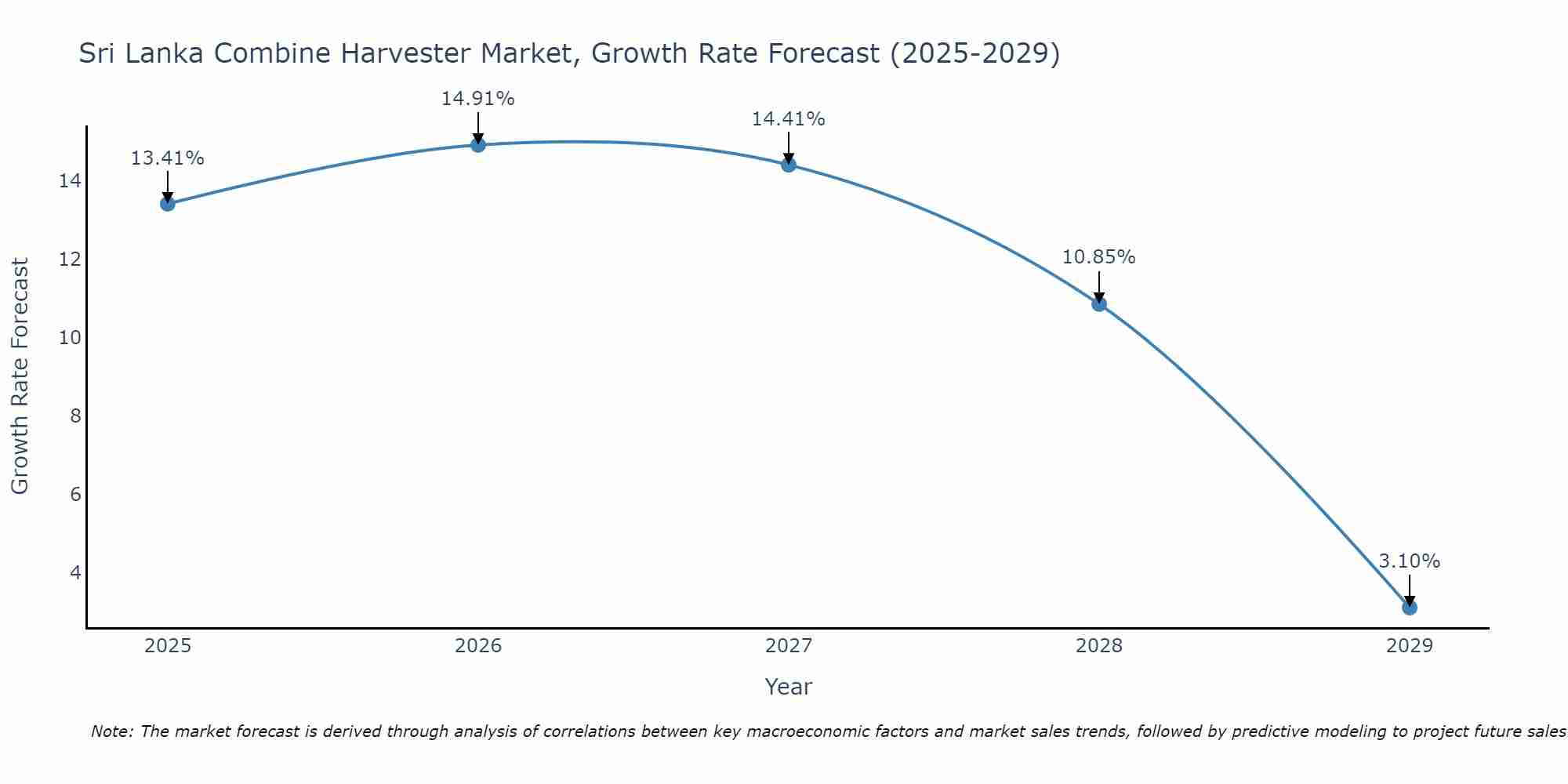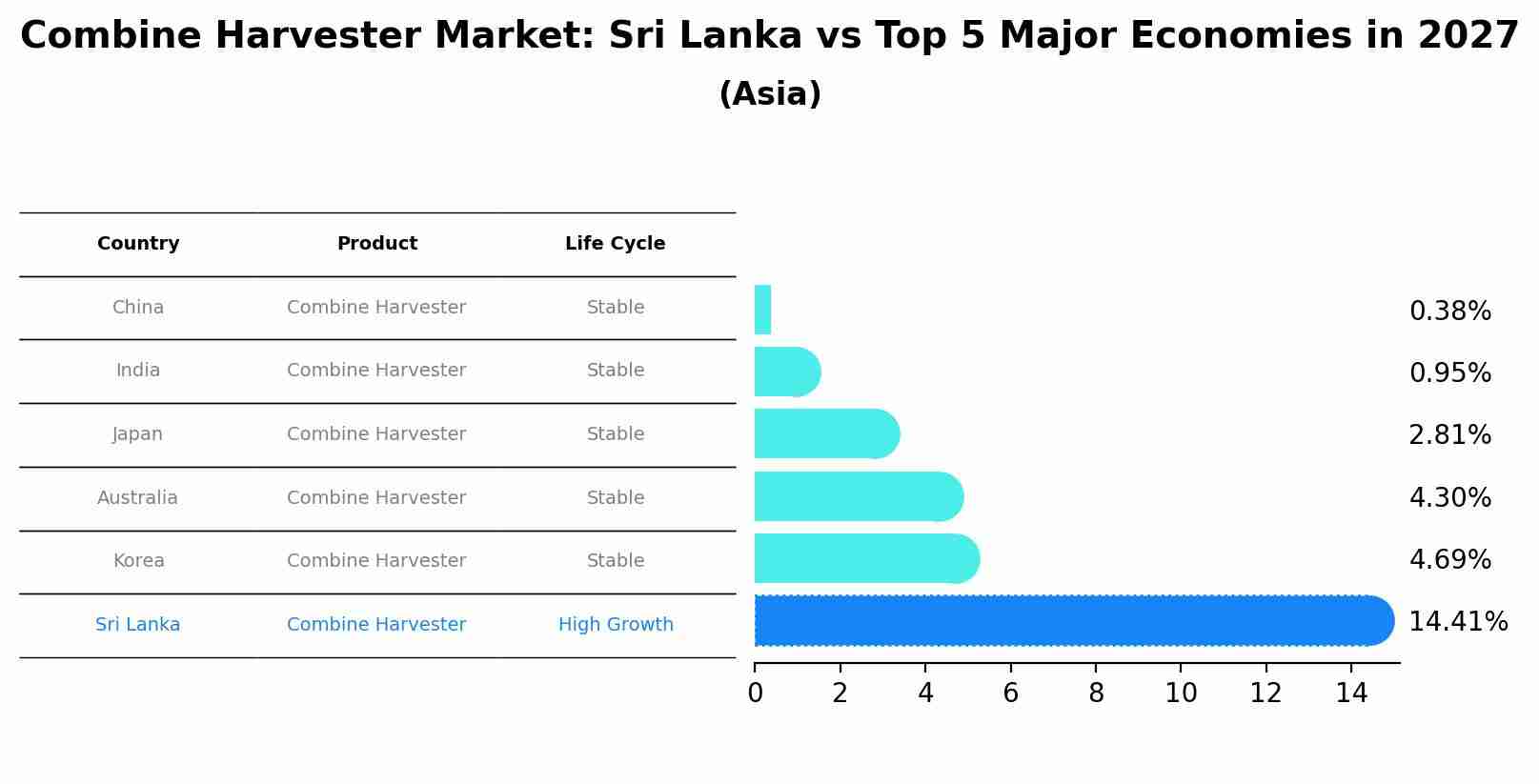Sri Lanka Combine Harvester Market Outlook | Revenue, Industry, Value, Analysis, Share, Companies, COVID-19 IMPACT, Trends, Size, Forecast & Growth
| Product Code: ETC428727 | Publication Date: Oct 2022 | Updated Date: Aug 2025 | Product Type: Market Research Report | |
| Publisher: 6Wresearch | Author: Ravi Bhandari | No. of Pages: 75 | No. of Figures: 35 | No. of Tables: 20 |
Sri Lanka Combine Harvester Market Size Growth Rate
The Sri Lanka Combine Harvester Market is projected to witness mixed growth rate patterns during 2025 to 2029. Starting at 13.41% in 2025, the market peaks at 14.91% in 2026, and settles at 3.10% by 2029.

Combine Harvester Market: Sri Lanka vs Top 5 Major Economies in 2027 (Asia)
By 2027, Sri Lanka's Combine Harvester market is forecasted to achieve a high growth rate of 14.41%, with China leading the Asia region, followed by India, Japan, Australia and South Korea.

Sri Lanka Combine Harvester Market Overview
The combine harvester market in Sri Lanka is on an upward trend, supported by the mechanization of agriculture and the need to improve crop yield and efficiency. Combine harvesters, which perform reaping, threshing, and winnowing in a single process, are essential in modern farming practices. The market growth is driven by government initiatives promoting agricultural mechanization, increasing awareness among farmers about the benefits of modern machinery, and the availability of financing options. The rising demand for food due to population growth also boosts the adoption of combine harvesters.
Drivers of the market
The combine harvester market in Sri Lanka is driven by the agricultural sector`s efforts to improve productivity and efficiency. As traditional farming practices evolve towards mechanization, there is a growing adoption of combine harvesters that enable efficient harvesting of multiple crops. Factors such as labor shortages, rising labor costs, and government support for agricultural mechanization contribute to the market`s growth.
Challenges of the market
The combine harvester market in Sri Lanka faces challenges related to agricultural practices and economic viability. While there is a growing demand for mechanization to improve farming efficiency and productivity, small land holdings and traditional farming methods prevail in rural areas. High initial costs, maintenance requirements, and access to financing options pose barriers to widespread adoption among smallholder farmers. Market stakeholders must address these challenges through targeted education, financial support, and localized product offerings.
Government Policy of the market
The combine harvester market in Sri Lanka is influenced by agricultural policies aimed at enhancing farm productivity and mechanization. The government promotes the adoption of modern agricultural machinery like combine harvesters through subsidies, loan programs, and technical support to farmers. These policies aim to reduce labor dependency in agriculture, improve crop yields, and ensure food security by facilitating the widespread adoption of efficient harvesting technologies across Sri Lanka agricultural sector.
Key Highlights of the Report:
- Sri Lanka Combine Harvester Market Outlook
- Market Size of Sri Lanka Combine Harvester Market, 2021
- Forecast of Sri Lanka Combine Harvester Market, 2028
- Historical Data and Forecast of Sri Lanka Combine Harvester Revenues & Volume for the Period 2018 - 2028
- Sri Lanka Combine Harvester Market Trend Evolution
- Sri Lanka Combine Harvester Market Drivers and Challenges
- Sri Lanka Combine Harvester Price Trends
- Sri Lanka Combine Harvester Porter's Five Forces
- Sri Lanka Combine Harvester Industry Life Cycle
- Historical Data and Forecast of Sri Lanka Combine Harvester Market Revenues & Volume By Cutting Width for the Period 2018 - 2028
- Historical Data and Forecast of Sri Lanka Combine Harvester Market Revenues & Volume By Small Size Combine Harvester for the Period 2018 - 2028
- Historical Data and Forecast of Sri Lanka Combine Harvester Market Revenues & Volume By Large Size Combine Harvester for the Period 2018 - 2028
- Historical Data and Forecast of Sri Lanka Combine Harvester Market Revenues & Volume By Type for the Period 2018 - 2028
- Historical Data and Forecast of Sri Lanka Combine Harvester Market Revenues & Volume By Wheel Type Combine Harvester for the Period 2018 - 2028
- Historical Data and Forecast of Sri Lanka Combine Harvester Market Revenues & Volume By Crawler Type Combine Harvester for the Period 2018 - 2028
- Historical Data and Forecast of Sri Lanka Combine Harvester Market Revenues & Volume By Power Source for the Period 2018 - 2028
- Historical Data and Forecast of Sri Lanka Combine Harvester Market Revenues & Volume By Tractor Pulled/PTO Powered Combine Harvester for the Period 2018 - 2028
- Historical Data and Forecast of Sri Lanka Combine Harvester Market Revenues & Volume By Self-Propelled Combine Harvester for the Period 2018 - 2028
- Sri Lanka Combine Harvester Import Export Trade Statistics
- Market Opportunity Assessment By Cutting Width
- Market Opportunity Assessment By Type
- Market Opportunity Assessment By Power Source
- Sri Lanka Combine Harvester Top Companies Market Share
- Sri Lanka Combine Harvester Competitive Benchmarking By Technical and Operational Parameters
- Sri Lanka Combine Harvester Company Profiles
- Sri Lanka Combine Harvester Key Strategic Recommendations
Frequently Asked Questions About the Market Study (FAQs):
1 Executive Summary |
2 Introduction |
2.1 Key Highlights of the Report |
2.2 Report Description |
2.3 Market Scope & Segmentation |
2.4 Research Methodology |
2.5 Assumptions |
3 Sri Lanka Combine Harvester Market Overview |
3.1 Sri Lanka Country Macro Economic Indicators |
3.2 Sri Lanka Combine Harvester Market Revenues & Volume, 2021 & 2028F |
3.3 Sri Lanka Combine Harvester Market - Industry Life Cycle |
3.4 Sri Lanka Combine Harvester Market - Porter's Five Forces |
3.5 Sri Lanka Combine Harvester Market Revenues & Volume Share, By Cutting Width, 2021 & 2028F |
3.6 Sri Lanka Combine Harvester Market Revenues & Volume Share, By Type, 2021 & 2028F |
3.7 Sri Lanka Combine Harvester Market Revenues & Volume Share, By Power Source, 2021 & 2028F |
4 Sri Lanka Combine Harvester Market Dynamics |
4.1 Impact Analysis |
4.2 Market Drivers |
4.2.1 Government support and subsidies for agricultural mechanization |
4.2.2 Increasing demand for efficient farming practices to improve productivity |
4.2.3 Growing adoption of technology in agriculture sector |
4.3 Market Restraints |
4.3.1 High initial investment costs associated with purchasing combine harvesters |
4.3.2 Limited awareness and education among farmers about the benefits of mechanization |
4.3.3 Infrastructure challenges in rural areas affecting the usage of combine harvesters |
5 Sri Lanka Combine Harvester Market Trends |
6 Sri Lanka Combine Harvester Market, By Types |
6.1 Sri Lanka Combine Harvester Market, By Cutting Width |
6.1.1 Overview and Analysis |
6.1.2 Sri Lanka Combine Harvester Market Revenues & Volume, By Cutting Width, 2018 - 2028F |
6.1.3 Sri Lanka Combine Harvester Market Revenues & Volume, By Small Size Combine Harvester, 2018 - 2028F |
6.1.4 Sri Lanka Combine Harvester Market Revenues & Volume, By Large Size Combine Harvester, 2018 - 2028F |
6.2 Sri Lanka Combine Harvester Market, By Type |
6.2.1 Overview and Analysis |
6.2.2 Sri Lanka Combine Harvester Market Revenues & Volume, By Wheel Type Combine Harvester, 2018 - 2028F |
6.2.3 Sri Lanka Combine Harvester Market Revenues & Volume, By Crawler Type Combine Harvester, 2018 - 2028F |
6.3 Sri Lanka Combine Harvester Market, By Power Source |
6.3.1 Overview and Analysis |
6.3.2 Sri Lanka Combine Harvester Market Revenues & Volume, By Tractor Pulled/PTO Powered Combine Harvester, 2018 - 2028F |
6.3.3 Sri Lanka Combine Harvester Market Revenues & Volume, By Self-Propelled Combine Harvester, 2018 - 2028F |
7 Sri Lanka Combine Harvester Market Import-Export Trade Statistics |
7.1 Sri Lanka Combine Harvester Market Export to Major Countries |
7.2 Sri Lanka Combine Harvester Market Imports from Major Countries |
8 Sri Lanka Combine Harvester Market Key Performance Indicators |
8.1 Average age of combine harvesters in operation |
8.2 Mechanization rate in the agriculture sector |
8.3 Adoption rate of precision farming technologies |
9 Sri Lanka Combine Harvester Market - Opportunity Assessment |
9.1 Sri Lanka Combine Harvester Market Opportunity Assessment, By Cutting Width, 2021 & 2028F |
9.2 Sri Lanka Combine Harvester Market Opportunity Assessment, By Type, 2021 & 2028F |
9.3 Sri Lanka Combine Harvester Market Opportunity Assessment, By Power Source, 2021 & 2028F |
10 Sri Lanka Combine Harvester Market - Competitive Landscape |
10.1 Sri Lanka Combine Harvester Market Revenue Share, By Companies, 2021 |
10.2 Sri Lanka Combine Harvester Market Competitive Benchmarking, By Operating and Technical Parameters |
11 Company Profiles |
12 Recommendations |
13 Disclaimer |
- Single User License$ 1,995
- Department License$ 2,400
- Site License$ 3,120
- Global License$ 3,795
Search
Thought Leadership and Analyst Meet
Our Clients
Related Reports
- Germany Breakfast Food Market (2026-2032) | Industry, Share, Growth, Size, Companies, Value, Analysis, Revenue, Trends, Forecast & Outlook
- Australia Briquette Market (2025-2031) | Growth, Size, Revenue, Forecast, Analysis, Trends, Value, Share, Industry & Companies
- Vietnam System Integrator Market (2025-2031) | Size, Companies, Analysis, Industry, Value, Forecast, Growth, Trends, Revenue & Share
- ASEAN and Thailand Brain Health Supplements Market (2025-2031) | Strategy, Consumer Insights, Analysis, Investment Trends, Opportunities, Growth, Size, Share, Industry, Revenue, Segments, Value, Segmentation, Supply, Forecast, Restraints, Outlook, Competition, Drivers, Trends, Demand, Pricing Analysis, Competitive, Strategic Insights, Companies, Challenges
- ASEAN Bearings Market (2025-2031) | Strategy, Consumer Insights, Analysis, Investment Trends, Opportunities, Growth, Size, Share, Industry, Revenue, Segments, Value, Segmentation, Supply, Forecast, Restraints, Outlook, Competition, Drivers, Trends, Demand, Pricing Analysis, Competitive, Strategic Insights, Companies, Challenges
- Europe Flooring Market (2025-2031) | Outlook, Share, Industry, Trends, Forecast, Companies, Revenue, Size, Analysis, Growth & Value
- Saudi Arabia Manlift Market (2025-2031) | Outlook, Size, Growth, Trends, Companies, Industry, Revenue, Value, Share, Forecast & Analysis
- Uganda Excavator, Crane, and Wheel Loaders Market (2025-2031) | Strategy, Consumer Insights, Analysis, Investment Trends, Opportunities, Growth, Size, Share, Industry, Revenue, Segments, Value, Segmentation, Supply, Forecast, Restraints, Outlook, Competition, Drivers, Trends, Demand, Pricing Analysis, Competitive, Strategic Insights, Companies, Challenges
- Rwanda Excavator, Crane, and Wheel Loaders Market (2025-2031) | Strategy, Consumer Insights, Analysis, Investment Trends, Opportunities, Growth, Size, Share, Industry, Revenue, Segments, Value, Segmentation, Supply, Forecast, Restraints, Outlook, Competition, Drivers, Trends, Demand, Pricing Analysis, Competitive, Strategic Insights, Companies, Challenges
- Kenya Excavator, Crane, and Wheel Loaders Market (2025-2031) | Strategy, Consumer Insights, Analysis, Investment Trends, Opportunities, Growth, Size, Share, Industry, Revenue, Segments, Value, Segmentation, Supply, Forecast, Restraints, Outlook, Competition, Drivers, Trends, Demand, Pricing Analysis, Competitive, Strategic Insights, Companies, Challenges
Industry Events and Analyst Meet
Whitepaper
- Middle East & Africa Commercial Security Market Click here to view more.
- Middle East & Africa Fire Safety Systems & Equipment Market Click here to view more.
- GCC Drone Market Click here to view more.
- Middle East Lighting Fixture Market Click here to view more.
- GCC Physical & Perimeter Security Market Click here to view more.
6WResearch In News
- Doha a strategic location for EV manufacturing hub: IPA Qatar
- Demand for luxury TVs surging in the GCC, says Samsung
- Empowering Growth: The Thriving Journey of Bangladesh’s Cable Industry
- Demand for luxury TVs surging in the GCC, says Samsung
- Video call with a traditional healer? Once unthinkable, it’s now common in South Africa
- Intelligent Buildings To Smooth GCC’s Path To Net Zero


















